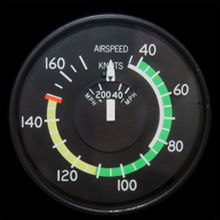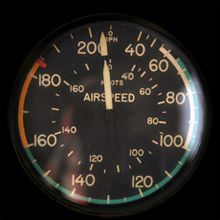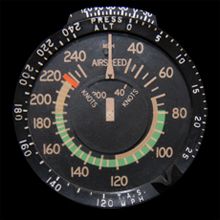Instruments – Airspeed Indicator
Some of the speeds you need to know are marked on the airspeed indicator but many are not. VS1, VS0, VFE, VNO, and VNE are almost always color coded on the ASI because they are required by the FAA. (Airplanes weighing 12,500 pounds or less, manufactured after 1945, and certificated by the FAA, are required to have airspeed indicators marked in accordance with a standard color-coded marking system. This system of color-coded markings enables a pilot to determine at a glance certain airspeed limitations that are important to the safe operation of the airplane. Handbook of Aeronautical Knowledge p 6-6)
Red is never exceed—the maximum allowable airspeed of the airplane, yellow is cautionary range—smooth air operation only, green is normal, white is normal flaps operating range. The bottom of the white arc indicates the stall speed with flaps extended, the bottom of the green arc is stall speed without flaps extended.

Cessna 152 Airspeed Indicator

Cessna 182 Airspeed Indicator

Cessna T210 Airspeed Indicator
At first glance these indicators appear to be different, but they all follow the same pattern as described in the table below. The 152 ASI shows airspeed in knots with a cutout that rotates with the needle showing MPH. The 182 and 210 ASIs show speed as MPH on the outer ring but the 172 has a fixed inner ring for knots and the 210 has a cutout like the 152. It also has an outer bezel that uses temperature and pressure altitude to show true airspeed (TAS) in MPH. Note also the colors. The 152 is a relatively new airplane compared to the 182 (1961) and 210 (1973) and its colors haven’t yellowed over time.
| VSpeed | Description | Color Code |
|---|---|---|
| VS1 | Stall speed “clean” | Bottom of the green arc |
| VS0 | Stall speed “dirty” | Bottom of the white arc |
| VFE | Maximum speed—Flaps extended | Top of the white arc |
| VNO | Maximum structural cruising speed | Top of green arc |
| VNE | Never exceed speed | Red line |
| Normal operating range | Green arc | |
| Flaps operating range | White arc | |
| Caution range | Yellow arc |
Stall speed “clean”—Flaps up, Gear up, max weight, power off.
Stall speed “dirty”—Flaps down, Gear down, max weight, power off. Bottom of the white arc.
Caution range—Operate only in smooth air with no turns.
| VSpeed | Description | Explantion |
|---|---|---|
| VX | Best angle climb speed | Obstacle clearance speed |
| VY | Best rate climb speed | Fastest climb to altitude |
| VA | Maneuvering speed | Maximum speed in turbulance |
| VLE | Maximum landing gear extended speed | Max speed for flying with gear down |
| VLO | Maximum landing gear operating speed | Max speed for extending or retracting gear |
| VFE-10° | Maximum speed—Flaps 10° Flaps extended | Some planes allow 10° of flaps outside of the white arc |
| VBG | Best glide speed | Airspeed for maximum distance power-off glide |
| VYSE | Single engine rate of climb speed | Twin engine, sometimes marked with a blue line |
| VR | Rotation speed | Speed for initiating rotation |
| VREF | Reference landing approach speed | Usually 1.3 x VS1 |
VA is dependent on weight. Higher weight is higher V speed. There is approximately a 1 percent decrease in maneuvering speed for every 2% increase in weight. Another general rule of thumb is that if you look at the ASI as a clock, VA is at 6:30.
VBG is also dependent upon weight. Best Glide Speed decreases as total aircraft weight decreases
VX increases slightly with altitude.
| V Speed | MPH | Knots |
|---|---|---|
| VX | 82 | 71 |
| VY | 110 | 96 |
| VA | 135 | 96 |
| VR | 70 | 61 |
| VLE | 160 | 139 |
| VLO | 160 | 139 |
| VFE 10° | 160 | 139 |
| VFE | 120 | 104 |
| VNE | 225 | 196 |
| VS0 | 65 | 56 |
| VS1 | 75 | 65 |
| VBG | 85-95 | 74-83 |
| V Speed | MPH | Knots |
|---|---|---|
| VX 20° Flaps | 60 | 52 |
| VY | 84 | 73 |
| VA | 128-123 | 111-107 |
| VR | 60 | 52 |
| VLE | NA | NA |
| VLO | NA | NA |
| VFE 10° | 110 | 96 |
| VFE | 110 | 96 |
| VNE | 193 | 168 |
| VS0 | 40 | 35 |
| VS1 | 60 | 52 |
| VBG | 85-95 | 74-83 |
Links:
Surecheck Aircraft V Speeds is a book that is available from PilotStore.com that claims to have V-Speeds for over 80 aircraft. I haven’t seen it but it sounds like something that would be useful if you fly a lot of different aircraft.
Whitt’s Flying has lots of information on airspeeds, but is a bit disorganized.
Wikipedia has lots of information on V-speeds that appears to be correct.
The FARs § 1.1 General definitions. define some V-speeds.
VA means design maneuvering speed.
VB means design speed for maximum gust intensity.
VC means design cruising speed.
VD means design diving speed.
VDF / MDF means demonstrated flight diving speed.
VEF means the speed at which the critical engine is assumed to fail during takeoff.
VF means design flap speed.
VFC / MFC means maximum speed for stability characteristics.
VFE means maximum flap extended speed.
VH means maximum speed in level flight with maximum continuous power.
VLE means maximum landing gear extended speed.
VLO means maximum landing gear operating speed.
VLOF means lift-off speed.
VMC means minimum control speed with the critical engine inoperative.
VMO / MMO means maximum operating limit speed.
VMU means minimum unstick speed.
VNE means never-exceed speed.
VNO means maximum structural cruising speed.
VR means rotation speed.
VS means the stalling speed or the minimum steady flight speed at which the airplane is controllable.


